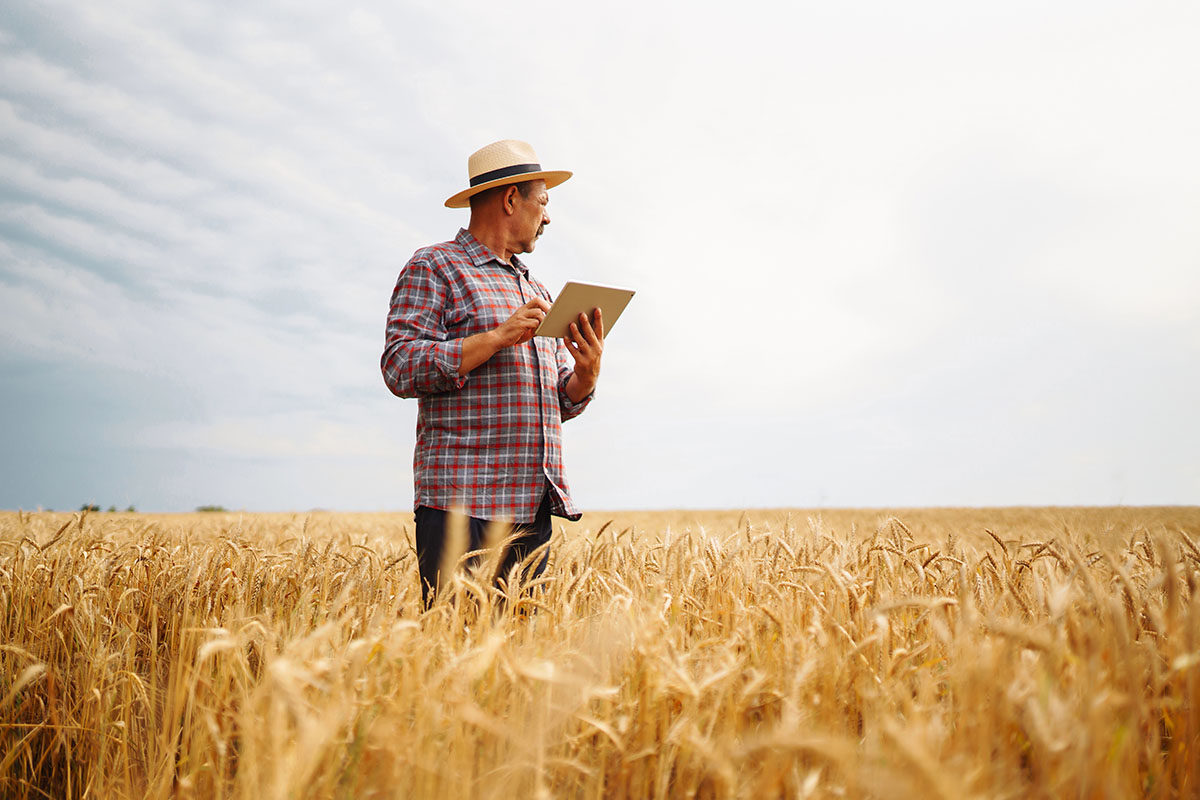The fall harvest season is a crucial time for agribusinesses, where every moment is important to gather crops before winter arrives. In today’s farming world, cybersecurity for agriculture is just as important as the physical tools used in the field.
Modern farms heavily depend on digital technologies—automated machinery, farm management software, IoT sensors—that make operations more efficient but also introduce new cyber risks.
During the harvest season, agribusinesses face higher cyber risks because any disruptions can delay or stop production, leading to significant financial losses and supply chain problems. Cyberattacks targeting farms during this busy period take advantage of vulnerabilities created by increased connectivity and reliance on cloud services.
To protect your harvest, it’s not enough to rely on traditional safety measures; proactive cyber readiness is necessary. This article explores how agribusinesses can strengthen their defenses and ensure the security of their digital systems throughout this critical time of year.
The Growing Digital Footprint of Agribusiness During Harvest Season
The fall harvest season sees a surge in the use of cutting-edge digital tools that have reshaped modern agriculture.
Automation in farming plays a critical role, with advanced machinery like GPS-guided combines and automated grain carts streamlining operations. Artificial Intelligence (AI) supports decision-making by analyzing weather data, crop health, and soil conditions in real-time. Internet of Things (IoT) devices agriculture relies on—such as soil moisture sensors, drones, and connected tractors—enable precision farming cybersecurity to become essential.
Benefits brought by these technologies include:
- Increased efficiency through reduced manual labor
- Enhanced crop yield predictions and resource management
- Faster response to changing field conditions
Yet, these advancements bring heightened cyber risks. Each IoT sensor or automated system represents a potential entry point for cyber attackers. Vulnerabilities in software updates or unsecured network connections can lead to unauthorized access or data breaches.
Harvest time magnifies the consequences of any cyber disruption. A ransomware attack locking down farm management software during peak activity can delay harvesting schedules, risking crop spoilage and financial loss. Even brief outages in communication between machines can cause costly downtime or operational errors.
Protecting the expanded digital footprint during this crucial season requires vigilance against emerging cyber threats while leveraging technology’s benefits to safeguard the harvest.
Common Cyber Threats Targeting Agriculture During Harvest Time
Harvest season puts agribusinesses at a heightened risk for cyberattacks. The rush to gather crops and maintain production schedules makes it easier for cybercriminals to exploit vulnerabilities. Here are some of the most common threats:
1. Ransomware Attacks on Farms
Ransomware can lock down critical systems like automated machinery controls or supply chain management platforms, halting operations just when timing is crucial. For example, if a ransomware attack targets a grain storage facility’s digital controls during harvest, the delay can cause spoilage and significant financial loss.
2. Phishing Scams in Agriculture
Phishing remains a top tactic to breach agriculture networks. Farm workers and staff may receive deceptive emails posing as trusted vendors or government agencies requesting login credentials or payment information. These scams often spike during harvest when communication volume is high, increasing the chance that someone will click a malicious link.
3. Insider Threats in Agribusiness
Employees with access to sensitive data or systems can unintentionally—or deliberately—cause damage. During harvest, the pressure and long hours might lead to mistakes like misconfiguring software or falling for social engineering attempts, opening doors for attackers.
4. IoT Device Exploits
Connected devices like soil sensors, drones, and automated irrigation systems are vulnerable points. Hackers may infiltrate these devices to disrupt data flow or gain deeper access into farm networks.
Understanding these specific risks tied to the fall harvest highlights why agriculture cybersecurity cannot be an afterthought but must be integrated into daily operations.
Case Studies: Lessons from High-Profile Agricultural Cyber Incidents
Cybersecurity for agriculture has faced significant tests during recent high-profile attacks that highlight vulnerabilities during critical production times. Two incidents stand out as cautionary tales for agribusinesses gearing up for the fall harvest:
1. JBS Foods Cyberattack (2021)
JBS Foods, one of the world’s largest meat processors, suffered a ransomware attack that forced temporary shutdowns across North America and Australia. This incident disrupted supply chains, delayed shipments, and caused immediate production halts during a key period for livestock processing. The attack demonstrated how cyber threats could ripple throughout the food supply chain, emphasizing the far-reaching consequences of compromised systems in agribusiness.
2. Dole Food Company Breach (2020)
Dole Food Company experienced a data breach exposing sensitive employee information and internal communications. Although not directly halting operations like JBS, this breach revealed weaknesses in protecting confidential data critical to business continuity and workforce trust. It underscored the importance of safeguarding personnel information alongside operational technology in farming enterprises.
These agricultural cyber incidents reveal common themes:
- Critical timing: Attacks targeting peak seasons like harvest or processing magnify operational and economic impacts.
- Supply chain vulnerability: Disruptions extend beyond single farms to affect distributors, retailers, and consumers.
- Data exposure risks: Protecting sensitive data remains as vital as defending machinery and software systems.
Learning from these events helps agribusinesses prioritize cybersecurity investments tailored to their unique challenges during the fall harvest season.
Why Agribusinesses Are Particularly Vulnerable This Fall Season
Agribusinesses face unique agriculture cybersecurity challenges that make them more susceptible to attacks during the fall harvest. Historically, many farms and agricultural companies have underinvested in cybersecurity. This lack of preparedness often stems from a traditional focus on physical farming operations rather than digital defense. Cybersecurity budgets tend to be limited, and expertise is frequently sparse, leaving critical systems exposed during one of the most crucial times of the year.
Expanded Risks During Fall
The fall season amplifies risks because the attack surface expands significantly. Farms increasingly rely on remote monitoring tools and cloud services to manage equipment, track crop conditions, and coordinate logistics. While these technologies boost efficiency and precision during harvest, they also open new entry points for cybercriminals.
Some specific vulnerabilities include:
- Unsecured IoT devices connected to farm machinery
- Cloud platforms without robust access controls
- Wireless networks that may not be properly segmented or encrypted
This broader digital footprint means that a single breach could disrupt harvesting schedules, supply chains, or even damage crop yields by tampering with automated irrigation or pesticide systems. Recognizing these factors is essential for protecting agribusinesses when every moment counts on the farm.
Essential Cybersecurity Measures to Stay Protected
Securing your agribusiness’s digital assets during the fall harvest requires practical, targeted steps that address the unique risks of this season. Farms and agricultural operations increasingly rely on connected devices and cloud services, making strong defenses critical.
Key measures to implement:
- Multi-factor authentication (MFA) farm-wide: Implement MFA for all users accessing farm management systems, IoT devices, and cloud platforms. This adds an extra layer of security beyond just passwords, reducing the risk of unauthorized access even if credentials are compromised.
- Regular software updates agribusiness-wide: Keep all hardware and software up to date with the latest security patches. Automated reminders and scheduled maintenance windows can ensure no critical vulnerabilities are left unpatched during the busy harvest season.
- Network segmentation: Separate critical operational technology (OT) like machinery control systems from general IT networks. This limits the spread of malware or ransomware infections if one part of the network is breached.
- Employee cybersecurity training: Farm workers often interact with digital tools but may not be fully aware of cyber risks. Short, focused training sessions about phishing scams and safe device use help build a human firewall.
- Backup and recovery plans: Maintain frequent backups of key data in multiple locations. Test recovery procedures regularly so that production can resume quickly after an incident without losing valuable harvest information.
These focused strategies form a security foundation designed specifically for agribusinesses navigating the high stakes and tight timelines of fall harvest operations.
Responding Effectively to Cyber Incidents During Harvest Time
When a cyberattack happens during the harvest season, it’s important to act quickly to reduce damage and downtime. Farms should have a clear plan in place that includes these immediate steps:
- Isolate infected machines: Quickly disconnect affected devices from the network to prevent the spread of malware or ransomware across critical systems controlling irrigation, machinery, or crop data.
- Notify key personnel: Alert your IT team or external cybersecurity experts who specialize in cybersecurity for agriculture to assess and contain the breach.
- Preserve evidence: Avoid shutting down systems abruptly unless instructed; maintaining logs and system snapshots helps forensic analysis and future prevention.
- Communicate carefully: Keep all staff informed with clear instructions but avoid sharing sensitive details broadly, which could worsen exposure or panic.
Being prepared for rapid containment during peak harvest protects not only digital assets but also ensures that physical operations continue smoothly without costly interruptions. This kind of readiness turns a potential disaster into a manageable setback.
Government Initiatives Supporting Agricultural Cyber Readiness This Fall Season
The Farm and Food Cybersecurity Act is a key legislative effort aimed at strengthening the agribusiness sector’s defenses against cyber threats.
This act focuses on funding research, developing best practices, and promoting information sharing between farmers, technology providers, and government agencies. It emphasizes the need for tailored cybersecurity solutions that address the unique challenges faced during critical periods like the fall harvest.
Initiatives like these reflect a growing recognition of agriculture as critical infrastructure needing proactive cybersecurity support. They create opportunities for farms to access resources, training, and threat intelligence specifically designed to secure operations during high-risk times like harvest season.
Preparing Your Farm’s Digital Defenses Before Next Harvest Season
Building a long-term farm cybersecurity strategy means treating security as an ongoing priority, not just a one-time fix during harvest. The agricultural sector’s digital landscape is constantly evolving, with new devices, software updates, and connected systems arriving year-round. Staying ahead requires continuous investment in both technology and training.
Key components to focus on include:
- Regular vulnerability assessments: Identify weak spots before attackers do.
- Consistent software patching: Keep all systems up to date to close security gaps.
- Employee cybersecurity education: Equip your team to recognize phishing attempts and suspicious activity.
- Backup and recovery plans: Ensure data integrity even if an incident occurs.
A resilient farm cybersecurity posture also involves adapting to emerging threats and technologies. For example, integrating threat intelligence feeds can help anticipate attacks targeting agricultural networks specifically. Making cybersecurity a foundational element of farm management preserves operational continuity well beyond the immediate risks of harvest season.
Stay Protected During the Harvest
Farms are facing an increasing number of digital threats as technology becomes essential for a successful harvest. To protect agricultural data fall and ensure smooth operations, agribusinesses must establish layered cybersecurity defenses immediately. This involves:
- Implementing strong authentication and encryption
- Keeping software up to date
- Educating workers about cyber awareness
- Regularly backing up critical information
By taking these measures, farms can strengthen their defenses against attacks that could disrupt the food supply chain during this critical period. Investing in cybersecurity for agriculture now not only protects this harvest but also ensures productivity and peace of mind for future seasons.
If you’d like to ensure your agricultural business is secure this harvest season, contact IPM Computers today! Our team has the experience and knowledge you can count on to help protect your harvest this year, and every year to come.





